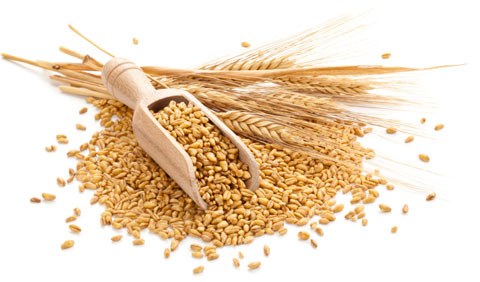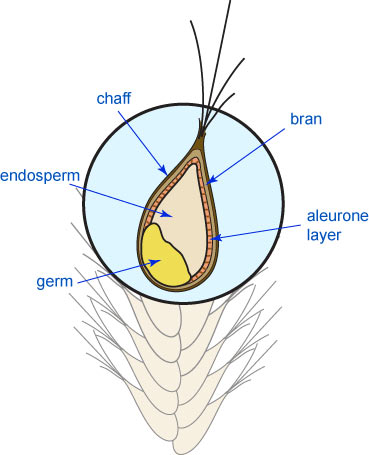Whole Wheat's Health Benefits
- Nutrients in Whole Wheat
- Evidence of Benefit
- Recommended Daily Intake
- Complex vs. Simple Carbohydrates
- Precautions

Fun Facts:
Storing baked goods in an area exposed to sunlight can deplete the essential thiamine B vitamin. The best place to store whole wheat and whole wheat products is in the refrigerator — which protects them from turning rancid and from nutrient degradation. (i.52, 74)
In ancient China, wheat is considered sacred. And in ancient Greece, Rome, and Sumeria wheat gods and goddesses were worshiped. (i.1)
Did you know that there is a cancer fighting food that has been around far longer than the disease has been identified? Historians suggest that wheat, an ancient grass, may have been on the menu for about 9,000 years, when evidence indicates it was first cultivated in the Middle East. Others suggest wheat may have originated in southwestern Asia over 12,000 years ago. (i.1, 62)
The part of the wheat plant we eat is commonly referred to as grain but is actually the seed kernel, or fruit, of the plant. Now the over 30,000 varieties of wheat have been categorized into six botanical classes based on hardness and color of the wheat seed kernel and when it is harvested (winter or spring). Harder, darker types have more protein, with the large, long gold-orange durum wheat kernels being the hardest. (i.63, 64)
Recent studies suggest that including wheat in your diet can help prevent cancer. In fact, according to a report issued by the American Institute for Cancer Research (AICR) foods rich in dietary fiber (such as whole grains) can help lower the risk of developing colorectal cancer. However, it is important to use whole wheat flour (or other foods made with whole wheat grain) in order to reap all the cancer-fighting nutritional benefits. That's because the most important micronutrients and fiber in whole wheat are in the parts removed during milling, and more are destroyed with bleaching or are lost when wheat flour is baked (e.g., vitamin E and carotenoids). (i.63, 65-67)
Beneficial Micronutrients in Whole Wheat
Whole grain on a food label means that all three parts of the kernel — germ, bran, and endosperm — are included in the whole wheat (or other grain) flour used to make the product. This differs from refined grains that routinely eliminate the bran, germ, and outer endosperm layer, leaving only the starchy endosperm interior. (i.66, 68, 69)
Whole wheat breads, cereals, and pastas contain the fiber, vitamins, minerals, and natural plant compounds that can help stave off serious ailments — including cancer. (i.66, 68)
Even if the manufacturers enrich the flour with nutrients, whole grains still have more fiber and nutrients. Studies show that the natural plant compounds (phytochemicals) in whole grains can help shelter human cells from the kinds of damage that might contribute to the onset of cancer. Other research cites specific whole wheat elements, such as fiber, that may be connected to lower cancer risk. These include: (i.52, 64, 66-76)
| ENDOSPERM | WHEAT GERM | BRAN | ||
|---|---|---|---|---|
| VITAMINS | Choline | ● | ||
| Folate | ● | |||
| Folic acid | ● | |||
| Niacin/ Nicotinic acid | ● | |||
| Riboflavin | ● | |||
| Thiamine | ● | ● | ||
| Vitamin A | ● | |||
| Vitamin B5 | ● | |||
| Vitamin B6 | ● | |||
| Vitamin E | ● | ● | ||
| Vitamin K | ● | |||
| MINERALS | Calcium | ● | ||
| Chromium | ||||
| Copper | ● | |||
| Germanium | ● | |||
| Iron | ● | |||
| Magnesium | ● | ● | ||
| Manganese | ● | |||
| Selenium | ● | |||
| Zinc | ● | ● | ||
| PROTEINS |
Glutens |
● |
||
|
Albumin |
● |
● | ● | |
|
Globulins |
● |
● | ● | |
| CARBOHYDRATES | Starches | ● | ||
|
Polysaccharide Fiber |
● | |||
| BENEFICIAL FATTY ACIDS | Alpha linolenic acid | ● | ● | |
| Linoleic acid | ● | |||
| ISOFLAVONOIDS | Daidzen | ● | ||
| Genistein | ● | |||
| AMINO ACIDS | Alanine | ● (mostly in the aleurone layer) |
● | |
| Arginine | ● (mostly in the aleurone layer) |
● | ||
| Asparagine | ● (mostly in the aleurone layer) |
● | ||
| Glutamine | ● | ● | ||
| Glycine |
● |
● | ||
| Histidine |
● |
|||
| Lysine |
● |
● | ||
| Proline | ● | ● | ||
| Threonine | ● | |||
| Tryptophan | ● | |||
| OTHER PHYTOCHEMICALS | Alkyl Resorcinols | ● | ||
| Beta carotene | ● | |||
| Betaine | ● | |||
| Beta-sitosterol | ● | |||
| Campesterol | ● | |||
| Coumaric acid | ● | |||
|
Enterolactone |
● | |||
|
Enterodiol |
||||
| Ferulic acid | ● | |||
| Lutein | ● | |||
| Zeaxanthin | ● | |||
Evidence of Cancer-Fighting Benefits
Population studies suggest that diets high in grains such as whole wheat is linked to lower risks of developing stomach, colon, and rectal cancers. In fact, analysis of 40 case studies involving different types of cancer found that people who ate more whole grains had 34% less incidence of cancer than those who ate less whole grains. A number of better-designed, prospective studies ranging from 5-15 years that followed large groups of men and women produced mixed results: (i.77, 78)
- Suggested decreased risk of cancer with high fiber and whole grain intake.
- Increased risk of cancer associated with diets low in fiber.
- No reduction of risk of cancer found with high fiber diets.
However, a massive systematic analysis of studies recently conducted and published in 2011 calculated a 10% risk reduction for colorectal cancer for every 10 grams of total fiber consumed each day and about a 20% reduction for every 90 grams of whole grain intake daily. These results indicate a dose-responsive relationship between dietary intake of both high fiber and whole grains and lowering the risk of these types of cancers, especially for whole cereal grains. The meta-analysis included 25 prospective studies together with case-control studies involving 12,000 cases that assessed the dietary intakes and cancer incidences in 1.7 million participants. (i.78)
Whole wheat's benefits in helping prevent or slow down the growth of cancer may be due to the antioxidant and other antitumor effects of the phytochemicals, fiber, and nutrients in the parts of wheat not found in refined wheat flour (e.g., the wheat germ and bran). (i.64)
For example, research shows that whole wheat and/or wheat germ and bran:
- Decreases bile acids. High amounts of bile acids in fecal matter can increase the risk of colon cancer, and studies demonstrate that the fiber and antioxidants in wheat germ lowers the concentration of these potentially carcinogenic acids. (i.79)
- Inhibits DNA damage. Phytochemical compounds stop DNA damage that leads to cancer development. (i.64)
- May lower high estrogen levels and help regulate hormones. Fiber is thought to reduce the higher estrogen hormone levels studies indicate are associated with higher risk of breast cancer. Higher intake of dietary fiber and phytoestrogens is linked to lower risk of ovarian and prostate cancers. (i.64)
- Blocks metastatic activity. Lab and animal studies show that whole wheat's phytoestrogens stop breast cancer cells from invading nearby tissue and spreading. (i.64)
The AICR report also recommends limiting energy dense foods (e.g., fast foods, animal fats, and sugary drinks) and keeping up with a diet mostly emphasizing vegetables, fruits, whole grains, and beans. This type of diet can help maintain a healthy weight while lowering chances of developing cancer. (i.63, 65)
The nutrients and fiber contained in whole wheat also help reduce the risk of heart disease, type-2 diabetes, and obesity, which studies show are associated with some forms of cancer — including prostate cancer. Other benefits include improved bowel movements and encouraging healthy bacteria growth in the colon. (i.65, 68, 80)
Recommended Daily Intake
The recommended daily intake of whole grains (such as whole wheat) is three servings a day, or at least 25 grams/day. Unfortunately only about 10% of the population sticks with the recommended healthy whole grain diet. (i.65, 68, 80)
Recent analysis of the diets of well over a million people suggest that consuming the equivalent of 90 grams of whole grains a day can have a significant impact on lowering the risk of colorectal cancers, and that higher intakes reduce the risks even further. (i.78)

Why Do Manufacturers Remove Wheat Germ and Bran?
One of the reasons manufacturers remove wheat bran is because it contains oils that can turn rancid and limit the shelf-life of whole wheat products. Products made with refined grains (including wheat) are easier to cook and the lighter color is more attractive to consumers. Cereals often have many sugars added (such as corn syrup) that create an appealing sweeter taste and require more processing of the grain. (i.65)
Whole grains are also more difficult to chew. In addition, even though bran contains potent antioxidant plant compounds such as ferulic acid, the argument can be made that it is bound up in the difficult-to-digest cellulose cell walls. However, this slower digestion may actually be beneficial since it gives the enzymes and microbes in the gut time to ferment and release these bound phenolic compounds. (i.64-65, 79)
What’s in a Name? Complex vs. Simple Carbohydrates
Part of that lack of adherence to keeping a beneficial level of complex carbohydrates in a healthy diet can be blamed on confusing labels. It is not easy to identify real whole wheat brands. Foods identified as multigrain, 100% wheat, brown, bran, and stone ground have healthy connotations but many of them do not deliver whole grain benefits. (i.68)
For example: (i.70)
- Brown bread could be made with whole wheat, but it may also be just refined white flour with caramel coloring.
- Stone ground just refers to a type of milling process that uses limestone for grinding.
- 100% wheat flour can be any refined or whole wheat flours — and may not include any whole wheat at all.
So is there a difference? Whole grains are complex carbohydrates that have more nutrients than even fortified cereals. They also have a lower glycemic index than products made with refined grains that are simple carbohydrates, and can help reduce the risk of disease. (i.65, 70)
One phrase on a product's label that makes finding real whole grains somewhat simpler is a specific U.S. Food and Drug Administration health claim reserved for whole grains. That FDA product notice states that whole grains and other plant foods are capable of reducing heart disease and some cancers. Only lower fat, whole-grain products containing at least 51 percent of whole grains (by weight) can carry this label. (i.68)
Is Organic Wheat Better?
The organic farming movement has influenced the wheat market, but not to the extent its adherents would favor. In fact, a study out of Germany says that despite the higher price typically found, organic wheat products' nutritional profile is essentially the same as conventional farming. However, while results say there are no "extreme differences" in the metabolic make-up and quality of wheat grains the German analysts did point out that organic farming uses less fertilizer and no herbicides or pesticides. (i.81)
Obviously, whole grains are available in many forms, but whole wheat tops the list. It is available in most grocery stores and incorporated in many different products. Whole wheat's reputation as a cancer fighter continues to grow, but that aspect of the grain depends on using nothing but the whole thing. Take full advantage of wheat's cancer-fighting abilities by making sure the cereal and baked goods you consume contain whole wheat.
Be Careful of Wheat Allergies and Mycotoxins
Immune System Issues. Those with celiac disease or food allergies to wheat will have to find other sources of fiber. Wheat is one of the eight different foods with proteins that cause the vast majority of food allergies. (i.82)
Mycotoxins. Produced by molds that contaminate food, mycotoxins are toxins that the fungi produce. Convincing evidence indicates these aflatoxins, a type of mycotoxin caused by Aspergillus flavus and Aspergillus parasiticus fungi, are carcinogenic and cause liver cancer in humans. They primarily contaminate cereal grains (e.g., wheat, rice, corn, and oats) and legumes (especially peanuts), and are not killed by cooking. Although mostly a problem in hot, humid climates (such as in the tropics) and suboptimal food storage conditions, aflatoxins can be found anywhere in the world and are exported or imported far from where they originate. (i.65)
Other mycotoxins found in wheat include: (i.83)
| MYCOTOXIN |
FUNGUS RESPONSIBLE |
TOXIC EFFECTS |
|---|---|---|
| Fumonisins | Fusarium species |
|
| Sterigmatocystin |
Aspergillus versicolor & other Aspergillus species |
|
| Trichothecenes | Fusarium species |
|
| Zearalenone | Fusarium graminearum |
|
Many countries monitor aflatoxin levels and use fungicide to keep them low. When consumed, they are activated by proteins called phase I enzymes, but enough natural phase II enzymes get rid of them before they can damage DNA. There are steps you can take (such as not eating moldy bread) to help lower the risk from mycotoxins. You may also try adding some spices such as turmeric to your diet that stimulate production of phase II enzymes in the body. (i.65, 84, 85)
Phytates. An undesirable compound in whole wheat, it binds to the beneficial minerals and reduces their nutritional availability in the body. Fermentation inactivates phytates. (i.72)



